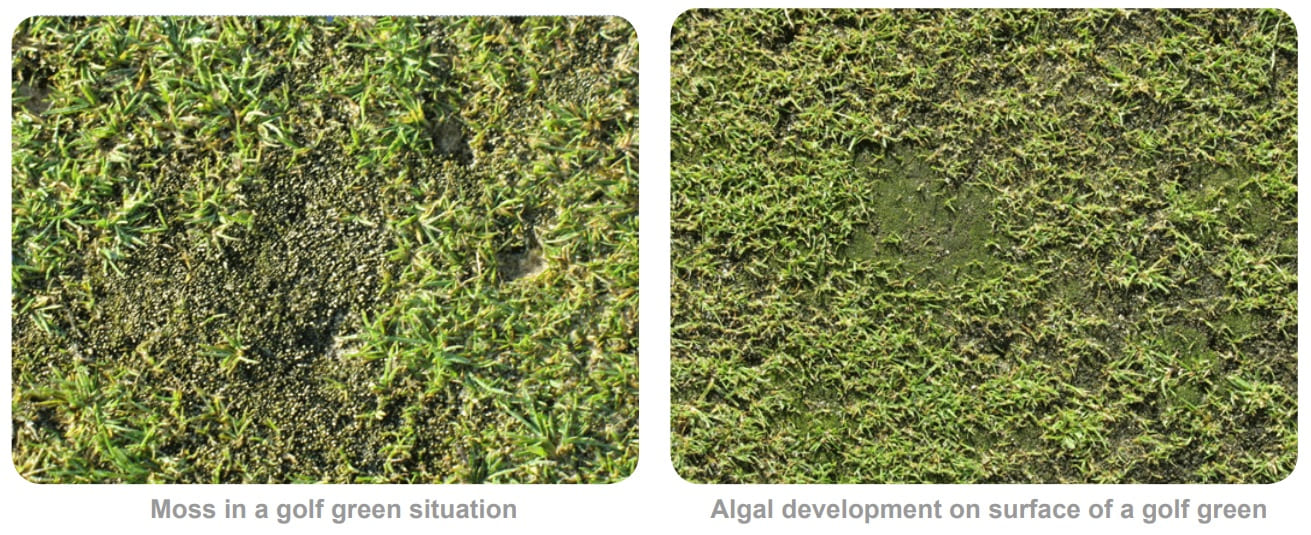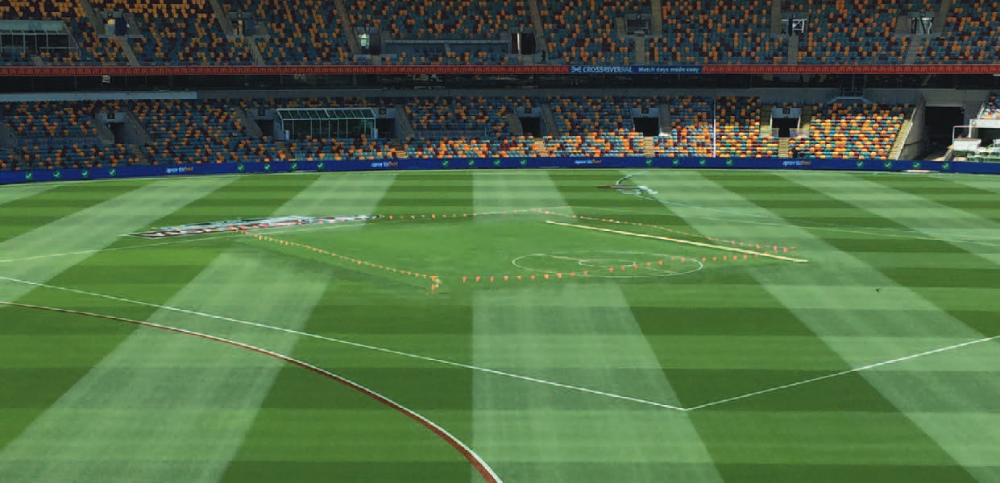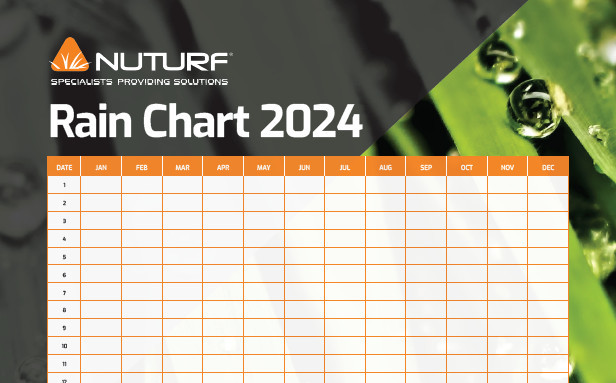How to Control Algae and Moss in Turf Management
What is algae?
Algae are photosynthetic organisms that occur in most habitats, ranging from marine and freshwater environments to desert sands and from hot boiling springs to snow and ice. They vary from small, single celled forms (the type primarily associated with turf ) to complex multicellular, long stringed forms (seaweed). Algae are found in fossil records dating back to approximately 3 billion years, emphasising their adaptive and competitive ability.
Species of algae are divided into 2 broad categories; the green algae, referred to as the true algae, and blue green algae, referred to as cyanobacteria. Genera associated with green algae (true algae) in turf are Chlamydomonas, Chlorococcum, Coccomyx, Cosmarium, Cylindrocystis. This group of algae is capable of occurring in large masses. Cyanobacteria (blue green algae) consists of the genus Anabaena, Lyngbya, Nostoc, Oscillatoria, Phormidium and Schizothrix.
What is moss?
Mosses are non-flowering green plants with leaves arising from all sides of a central axis. These plants are well adapted to grow in fully or seasonally moist habitats, although you will find some mosses growing in deserts or on windswept plateaus of Antarctica. All known mosses are less than 20cm tall.
They have leaflike, stemlike and rootlike parts, but these do not contain xylem and phloem, which are the water and food conducting tissues found in most plants. Moss leaves are very small and extremely thin. Only one cell thick over most of their area. Every cell is in direct contact with the air.
Algae and Moss in Turf
Although moss and algae are very different in anatomy, they share two major similarities:
- They both grow well in moist, compacted soil conditions and
- They are capable of drying out, then reviving after absorbing moisture. In general, Algae prefer humid, sunny conditions, whilst mosses are most competitive in shaded environments.
Algae form a thin dense green scum over the soil surface. This scum helps to form a tough black crust which when dry acts as a barrier impeding the entrance of water and nutrients in the soil. This can significantly impact on turfgrass uniformity and appearance. Mosses typically form a thick green mat at the soil surface. They prefer an acidic pH, and an unhealthy turf stand with which they can compete aggressively.

Cultural control of Algae and Moss in Turf
The most appropriate method for algae and moss control is by improving turf growing conditions, so that excess moisture is limited. This can be undertaken in most circumstances by improving the drainage capacity of the soil. Increasing air movement and improving irrigation scheduling can also help in the reduction of algae and moss incidence.
Cultural practices such as coring, verti-draining or physically raking out moss and algae scum, although time consuming, is also an effective cultural practice which can quickly remove the algae and moss from the turf sward, improving aesthetic appearance.
Correction of soil pH can also assist in the prevention of moss problems by using calcium (Lime) amendments. The secondary benefit of this is by decreasing acidity nutrients availability will improve, making the turf sward healthier, and in the process improving the turf’s ability to compete against moss invasion.
In addition, optimising the soil’s nutrient balance, is one of the most important factors in reducing moss and algae incidence. By maintaining an optimum balance of your major cations (Ca, Mg, K, Na), soil structure will significantly improve and maybe even be enough to significantly limit the build up of moss and algae populations.
Chemical and Fertiliser control of Algae and Moss
Knowing what kind of algae or moss you may have on your greens or turf situation is important. Like other types of weed control, algae and moss respond differently to chemical treatment, indicating why control can at times be erratic.
Fungicides
Curative control of moss and algae has been undertaken in the past by use of fungicidal applications with mancozeb (Penncozeb 750DF) or chlorothalonil (Daconil). These fungicides have been useful in reducing the population of both moss and algae. In Australia, only Mancozeb is registered for the control of algae in turf. Generally, several applications are used at weekly intervals to restrict algal and moss growth only. Full control is difficult to achieve when using this method only. Chlorothalonil (Daconil) has been reported in the US to control certain mosses by as much as 45% from one application.
Algaecides
There are several algacides currently sold to the turf industry in Australia. Dichlorophen (Kendocide) has been used with varying success in certain situations for the control of algae. Before using this product it is recommended that the turf is spiked or verti-drained to enhance penetration of the chemical.
Surrender (Benzalkonium chloride) is another algacide used for the control of moss and algae in turf. Used in pool algacides, benzalkonium chloride has been effective in controlling moss in particular. It is safe for use on couch and bent surfaces, however it is recommended that the turf be adequately fertilised before application is undertaken. Rate of application is 250ml per 10 litres of water per 100 sq m.
Herbicides
Silverado is a recently registered herbicide containing the active ingredients Carfentrazone and MCPA. With repeated applications at 14 days intervals, Silverado is very effective in controlling problematic Moss (trials have shown greater than 90%). Silverado works by inhibiting a key enzyme in moss chlorophyll production. The rate of Silverado is 10g/100m2 (1kg/ha).
Fertiliser Application
Iron applications have been used to dehydrate the algae or moss turning them blackish brown in colour with eventual death occurring. Ferrous sulphate is commonly used at a rate of 95-280g/100sq m (9.5kg – 28kg/Ha) with varying degrees of success.
Combined Approach
Ultimately in the fight against moss and algae many forms of management tools need to be employed. Hence, herbicides, soil amendment, algaecides and fertiliser applications all need to be put into an effective program to get on top of the problem. Your Nuturf Territory Manager is well equipped to assist you in constructing these programs.
Control of Algae in Water
As well as creating problems in turf situations, the other aspect of which algae affects turf management is proliferation in water storage containers. Freshwater algae build up in water is generally associated with high nutrient loading or low oxygen levels in the water. Therefore, if algal blooms in the water source are of a regular occurrence, investigation needs to be undertaken, to identify the source of the problem. This may be run-off into the water source is high in nutrient, particularly Phosphorus and Nitrogen, or aeration needs to be undertaken, if oxygen levels are low. This can be tested for in a laboratory under a method called COD (Chemical Oxygen demand). Nuturf provides an environmental water analysis which includes, Total N, P and COD.
For dams filled with sludge, Biostim can assist. Available in pellets or powder, Biostim is a probiotic that feeds the aerobic bacteria in water bodies causing them to actively produce enzymes that speed up the breakdown of organic waste and degrading sludge. Getting rid of sludge also helps reduce algae and weeds as the sludge acts as a fertiliser for these pests.
In terms of algaecides in water, the commonly used forms are based on copper or chlorine salts. In the past copper sulphate has been used. The negatives of these materials are that they are toxic to fish and copper is highly corrosive. As a result, these limitations largely restricted their usage.
Coptrol is a new generation algaecide which consists of a copper compound surrounded by an organic chelating agent. Algae actively seek Coptrol for its nutrient value of the organic chelating agent and die on ingestion as they become exposed to the copper. The manufacturers of the product claim that because the copper is chelated, coptrol will not corrode metal surfaces such as water tanks, irrigation equipment, valves and pumps. It is said to be safe for fish and plants.













